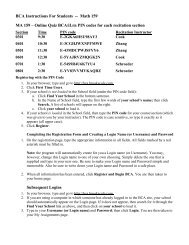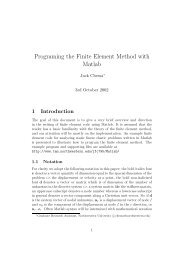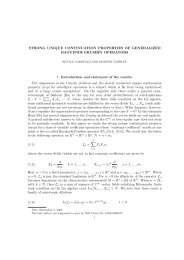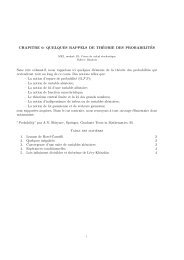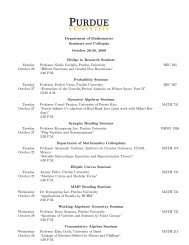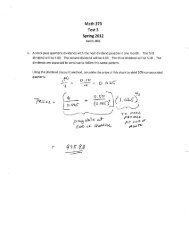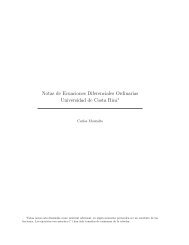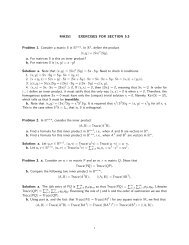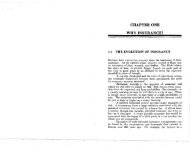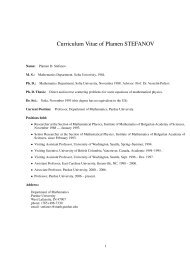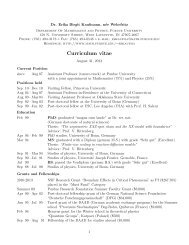The Kernel and Range of a Linear Transformation
The Kernel and Range of a Linear Transformation
The Kernel and Range of a Linear Transformation
Create successful ePaper yourself
Turn your PDF publications into a flip-book with our unique Google optimized e-Paper software.
360 CHAPTER 5 <strong>Linear</strong> <strong>Transformation</strong>s<br />
For Problems 5–12, describe the transformation <strong>of</strong> R2 with<br />
the given matrix as a product <strong>of</strong> reflections, stretches, <strong>and</strong><br />
shears.<br />
<br />
12<br />
5. A = .<br />
01<br />
6. A =<br />
7. A =<br />
8. A =<br />
9. A =<br />
<br />
02<br />
.<br />
20<br />
<br />
10<br />
.<br />
31<br />
<br />
−1 0<br />
.<br />
0 −1<br />
<br />
1 −3<br />
.<br />
−2 8<br />
<br />
12<br />
10. A = .<br />
34<br />
<br />
1 0<br />
11. A = .<br />
0 −2<br />
<br />
−1 −1<br />
12. A = .<br />
−1 0<br />
13. Consider the transformation <strong>of</strong> R 2 corresponding to a<br />
counterclockwise rotation through angle θ (0 ≤ θ<<br />
2π). For θ = π/2, 3π/2, verify that the matrix <strong>of</strong> the<br />
transformation is given by (5.2.5), <strong>and</strong> describe it in<br />
terms <strong>of</strong> reflections, stretches, <strong>and</strong> shears.<br />
14. Express the transformation <strong>of</strong> R 2 corresponding to a<br />
counterclockwise rotation through an angle θ = π/2<br />
as a product <strong>of</strong> reflections, stretches, <strong>and</strong> shears. Repeat<br />
for the case θ = 3π/2.<br />
5.3 <strong>The</strong> <strong>Kernel</strong> <strong>and</strong> <strong>Range</strong> <strong>of</strong> a <strong>Linear</strong> <strong>Transformation</strong><br />
If T : V → W is any linear transformation, there is an associated homogeneous linear<br />
vector equation, namely,<br />
T(v) = 0.<br />
<strong>The</strong> solution set to this vector equation is a subset <strong>of</strong> V called the kernel <strong>of</strong> T .<br />
DEFINITION 5.3.1<br />
Let T : V → W be a linear transformation. <strong>The</strong> set <strong>of</strong> all vectors v ∈ V such that<br />
T(v) = 0 is called the kernel <strong>of</strong> T <strong>and</strong> is denoted Ker(T ). Thus,<br />
Ker(T ) ={v ∈ V : T(v) = 0}.<br />
Example 5.3.2 Determine Ker(T ) for the linear transformation T : C 2 (I) → C 0 (I) defined by T(y)=<br />
y ′′ + y.<br />
Solution: We have<br />
Ker(T ) ={y ∈ C 2 (I) : T(y)= 0} ={y ∈ C 2 (I) : y ′′ + y = 0 for all x ∈ I}.<br />
Hence, in this case, Ker(T ) is the solution set to the differential equation<br />
y ′′ + y = 0.<br />
Since this differential equation has general solution y(x) = c1 cos x + c2 sin x,wehave<br />
Ker(T ) ={y ∈ C 2 (I) : y(x) = c1 cos x + c2 sin x}.<br />
This is the subspace <strong>of</strong> C 2 (I) spanned by {cos x,sin x}. <br />
<strong>The</strong> set <strong>of</strong> all vectors in W that we map onto when T is applied to all vectors in V is<br />
called the range <strong>of</strong> T . We can think <strong>of</strong> the range <strong>of</strong> T as being the set <strong>of</strong> function output<br />
values. A formal definition follows.
5.3 <strong>The</strong> <strong>Kernel</strong> <strong>and</strong> <strong>Range</strong> <strong>of</strong> a <strong>Linear</strong> <strong>Transformation</strong> 361<br />
DEFINITION 5.3.3<br />
<strong>The</strong> range <strong>of</strong> the linear transformation T : V → W is the subset <strong>of</strong> W consisting <strong>of</strong><br />
all transformed vectors from V . We denote the range <strong>of</strong> T by Rng(T ). Thus,<br />
Rng(T ) ={T(v) : v ∈ V }.<br />
A schematic representation <strong>of</strong> Ker(T ) <strong>and</strong> Rng(T ) is given in Figure 5.3.1.<br />
Ker(T)<br />
0<br />
Every vector in Ker(T) is mapped<br />
to the zero vector in W<br />
V<br />
Rng(T)<br />
Figure 5.3.1: Schematic representation <strong>of</strong> the kernel <strong>and</strong> range <strong>of</strong> a linear transformation.<br />
Let us now focus on matrix transformations, say T : Rn → Rm . In this particular<br />
case,<br />
Ker(T ) ={x ∈ R n : T(x) = 0}.<br />
If we let A denote the matrix <strong>of</strong> T , then T(x) = Ax, so that<br />
Consequently,<br />
Ker(T ) ={x ∈ R n : Ax = 0}.<br />
If T : R n → R m is the linear transformation with matrix A, then Ker(T ) is<br />
the solution set to the homogeneous linear system Ax = 0.<br />
In Section 4.3, we defined the solution set to Ax = 0 to be nullspace(A). <strong>The</strong>refore, we<br />
have<br />
Ker(T ) = nullspace(A), (5.3.1)<br />
from which it follows directly that 2 Ker(T ) is a subspace <strong>of</strong> R n . Furthermore, for a linear<br />
transformation T : R n → R m ,<br />
Rng(T ) ={T(x) : x ∈ R n }.<br />
If A =[a1, a2,...,an] denotes the matrix <strong>of</strong> T , then<br />
Rng(T ) ={Ax : x ∈ R n }<br />
={x1a1 + x2a2 +···+xnan : x1,x2,...,xn ∈ R}<br />
= colspace(A).<br />
Consequently, Rng(T ) is a subspace <strong>of</strong> R m . We illustrate these results with an example.<br />
Example 5.3.4 Let T : R 3 → R 2 be the linear transformation with matrix<br />
A =<br />
<br />
1 −2 5<br />
.<br />
−2 4 −10<br />
2 It is also easy to verify this fact directly by using Definition 5.3.1 <strong>and</strong> <strong>The</strong>orem 4.3.2.<br />
0<br />
W
362 CHAPTER 5 <strong>Linear</strong> <strong>Transformation</strong>s<br />
Determine Ker(T ) <strong>and</strong> Rng(T ).<br />
Solution: To determine Ker(T ), (5.3.1) implies that we need to find the solution set<br />
to the system Ax = 0. <strong>The</strong> reduced row-echelon form <strong>of</strong> the augmented matrix <strong>of</strong> this<br />
system is <br />
1 −2 50<br />
,<br />
0 000<br />
so that there are two free variables. Setting x2 = r <strong>and</strong> x3 = s, it follows that x1 = 2r−5s,<br />
so that x = (2r − 5s, r, s). Hence,<br />
Ker(T ) ={x ∈ R 3 : x = (2r − 5s, r, s): r, s ∈ R}<br />
={x ∈ R 3 : x = r(2, 1, 0) + s(−5, 0, 1), r, s ∈ R}.<br />
We see that Ker(T ) is the two-dimensional subspace <strong>of</strong> R 3 spanned by the linearly<br />
independent vectors (2, 1, 0) <strong>and</strong> (−5, 0, 1), <strong>and</strong> therefore it consists <strong>of</strong> all points lying<br />
on the plane through the origin that contains these vectors. We leave it as an exercise to<br />
verify that the equation <strong>of</strong> this plane is x1 − 2x2 + 5x3 = 0. <strong>The</strong> linear transformation<br />
T maps all points lying on this plane to the zero vector in R 2 . (See Figure 5.3.2.)<br />
x 1<br />
x 3<br />
x 1 2x 2 5x 3 0<br />
Ker(T)<br />
x<br />
x 2<br />
y 2 2y 1<br />
y 2<br />
Rng(T)<br />
T(x)<br />
Figure 5.3.2: <strong>The</strong> kernel <strong>and</strong> range <strong>of</strong> the linear transformation in Example 5.3.6.<br />
Turning our attention to Rng(T ), recall that, since T is a matrix transformation,<br />
Rng(T ) = colspace(A).<br />
From the foregoing reduced row-echelon form <strong>of</strong> A we see that colspace(A) is generated<br />
by the first column vector in A. Consequently,<br />
Rng(T ) ={y ∈ R 2 : y = r(1, −2), r ∈ R}.<br />
Hence, the points in Rng(T ) lie along the line through the origin in R2 whose direction<br />
is determined by v = (1, −2). <strong>The</strong> Cartesian equation <strong>of</strong> this line is y2 = −2y1.<br />
Consequently, T maps all points in R3 onto this line, <strong>and</strong> therefore Rng(T ) is a onedimensional<br />
subspace <strong>of</strong> R2 . This is illustrated in Figure 5.3.2. <br />
To summarize, any matrix transformation T : Rn → Rm with m × n matrix A has<br />
natural subspaces<br />
Ker(T ) = nullspace(A) (subspace <strong>of</strong> R n )<br />
Rng(T ) = colspace(A) (subspace <strong>of</strong> R m )<br />
Now let us return to arbitrary linear transformations. <strong>The</strong> preceding discussion has<br />
shown that both the kernel <strong>and</strong> range <strong>of</strong> any linear transformation from R n to R m are<br />
y 1
5.3 <strong>The</strong> <strong>Kernel</strong> <strong>and</strong> <strong>Range</strong> <strong>of</strong> a <strong>Linear</strong> <strong>Transformation</strong> 363<br />
subspaces <strong>of</strong> R n <strong>and</strong> R m , respectively. Our next result, which is fundamental, establishes<br />
that this is true in general.<br />
<strong>The</strong>orem 5.3.5 If T : V → W is a linear transformation, then<br />
1. Ker(T ) is a subspace <strong>of</strong> V .<br />
2. Rng(T ) is a subspace <strong>of</strong> W.<br />
Pro<strong>of</strong> In this pro<strong>of</strong>, we once more denote the zero vector in W by 0W . Both Ker(T )<br />
<strong>and</strong> Rng(T ) are necessarily nonempty, since, as we verified in Section 5.1, any linear<br />
transformation maps the zero vector in V to the zero vector in W. We must now establish<br />
that Ker(T ) <strong>and</strong> Rng(T ) are both closed under addition <strong>and</strong> closed under scalar<br />
multiplication in the appropriate vector space.<br />
1. If v1 <strong>and</strong> v2 are in Ker(T ), then T(v1) = 0W <strong>and</strong> T(v2) = 0W . We must show<br />
that v1 + v2 is in Ker(T ); that is, T(v1 + v2) = 0W . But we have<br />
T(v1 + v2) = T(v1) + T(v2) = 0W + 0W = 0W ,<br />
so that Ker(T ) is closed under addition. Further, if c is any scalar,<br />
T(cv1) = cT (v1) = c0W = 0W ,<br />
which shows that cv1 is in Ker(T ), <strong>and</strong> so Ker(T ) is also closed under scalar<br />
multiplication. Thus, Ker(T ) is a subspace <strong>of</strong> V .<br />
2. If w1 <strong>and</strong> w2 are in Rng(T ), then w1 = T(v1) <strong>and</strong> w2 = T(v2) for some v1 <strong>and</strong><br />
v2 in V . Thus,<br />
w1 + w2 = T(v1) + T(v2) = T(v1 + v2).<br />
This says that w1 +w2 arises as an output <strong>of</strong> the transformation T ; that is, w1 +w2<br />
is in Rng(T ). Thus, Rng(T ) is closed under addition. Further, if c is any scalar,<br />
then<br />
cw1 = cT (v1) = T(cv1),<br />
so that cw1 is the transform <strong>of</strong> cv1, <strong>and</strong> therefore cw1 is in Rng(T ). Consequently,<br />
Rng(T ) is a subspace <strong>of</strong> W.<br />
Remark We can interpret the first part <strong>of</strong> the preceding theorem as telling us that if T<br />
is a linear transformation, then the solution set to the corresponding linear homogeneous<br />
problem<br />
T(v) = 0<br />
is a vector space. Consequently, if we can determine the dimension <strong>of</strong> this vector space,<br />
then we know how many linearly independent solutions are required to build every<br />
solution to the problem. This is the formulation for linear problems that we have been<br />
looking for.<br />
Example 5.3.6 Find Ker(S), Rng(S), <strong>and</strong> their dimensions for the linear transformation S : M2(R) →<br />
M2(R) defined by<br />
S(A) = A − A T .
364 CHAPTER 5 <strong>Linear</strong> <strong>Transformation</strong>s<br />
Solution: In this case,<br />
Ker(S) ={A ∈ M2(R): S(A) = 0} ={A ∈ M2(R): A − A T = 02}.<br />
Thus, Ker(S) is the solution set <strong>of</strong> the matrix equation<br />
so that the matrices in Ker(S) satisfy<br />
A − A T = 02,<br />
A T = A.<br />
Hence, Ker(S) is the subspace <strong>of</strong> M2(R) consisting <strong>of</strong> all symmetric 2 × 2 matrices. We<br />
have shown previously that a basis for this subspace is<br />
<br />
10<br />
,<br />
00<br />
<br />
01<br />
,<br />
10<br />
<br />
00<br />
,<br />
01<br />
so that dim[Ker(S)] = 3. We now determine the range <strong>of</strong> S:<br />
Rng(S) ={S(A): A ∈ M2(R)} ={A− A T : A ∈ M2(R)}<br />
<br />
<br />
ab a c<br />
= − : a, b, c, d ∈ R<br />
cd bd<br />
<br />
<br />
0 b − c<br />
=<br />
: b, c ∈ R .<br />
−(b − c) 0<br />
Thus,<br />
<br />
0 e<br />
01<br />
Rng(S) = : e ∈ R = span .<br />
−e 0<br />
−1 0<br />
Consequently, Rng(S) consists <strong>of</strong> all skew-symmetric 2 ×2 matrices with real elements.<br />
Since Rng(S) is generated by the single nonzero matrix<br />
<br />
01<br />
,<br />
−1 0<br />
it follows that a basis for Rng(S) is<br />
<br />
01<br />
,<br />
−1 0<br />
so that dim[Rng(S)] = 1. <br />
Example 5.3.7 Let T : P1 → P2 be the linear transformation defined by<br />
T(a+ bx) = (2a − 3b) + (b − 5a)x + (a + b)x 2 .<br />
Find Ker(T ), Rng(T ), <strong>and</strong> their dimensions.<br />
Solution: From Definition 5.3.1,<br />
Ker(T ) ={p ∈ P1 : T(p)= 0}<br />
={a + bx : (2a − 3b) + (b − 5a)x + (a + b)x 2 = 0 for all x}<br />
={a + bx : a + b = 0, b− 5a = 0, 2a − 3b = 0}.
5.3 <strong>The</strong> <strong>Kernel</strong> <strong>and</strong> <strong>Range</strong> <strong>of</strong> a <strong>Linear</strong> <strong>Transformation</strong> 365<br />
But the only values <strong>of</strong> a <strong>and</strong> b that satisfy the conditions<br />
a + b = 0, b− 5a = 0, 2a − 3b = 0<br />
are<br />
a = b = 0.<br />
Consequently, Ker(T ) contains only the zero polynomial. Hence, we write<br />
Ker(T ) ={0}.<br />
It follows from Definition 4.6.7 that dim[Ker(T )] = 0. Furthermore,<br />
Rng(T ) ={T(a+ bx): a,b ∈ R} ={(2a − 3b) + (b − 5a)x + (a + b)x 2 : a,b ∈ R}.<br />
To determine a basis for Rng(T ), we write this as<br />
Rng(T ) ={a(2 − 5x + x 2 ) + b(−3 + x + x 2 ) : a,b ∈ R}<br />
= span{2 − 5x + x 2 , −3 + x + x 2 }.<br />
Thus, Rng(T ) is spanned by p1(x) = 2 − 5x + x 2 <strong>and</strong> p2(x) =−3 + x + x 2 . Since<br />
p1 <strong>and</strong> p2 are not proportional to one another, they are linearly independent on any<br />
interval. Consequently, a basis for Rng(T ) is {2 − 5x + x 2 , −3 + x + x 2 }, so that<br />
dim[Rng(T )] = 2. <br />
<strong>The</strong> General Rank-Nullity <strong>The</strong>orem<br />
In concluding this section, we consider a fundamental theorem for linear transformations<br />
T : V → W that gives a relationship between the dimensions <strong>of</strong> Ker(T ), Rng(T ), <strong>and</strong><br />
V . This is a generalization <strong>of</strong> the Rank-Nullity <strong>The</strong>orem considered in Section 4.9. <strong>The</strong><br />
theorem here, <strong>The</strong>orem 5.3.8, reduces to the previous result, <strong>The</strong>orem 4.9.1, in the case<br />
when T is a linear transformation from R n to R m with m × n matrix A. Suppose that<br />
dim[V ]=n <strong>and</strong> that dim[Ker(T )] = k. <strong>The</strong>n k-dimensions worth <strong>of</strong> the vectors in V<br />
are all mapped onto the zero vector in W. Consequently, we only have n − k dimensions<br />
worth <strong>of</strong> vectors left to map onto the remaining vectors in W. This suggests that<br />
dim[Rng(T )] = dim[V ]−dim[Ker(T )].<br />
This is indeed correct, although a rigorous pro<strong>of</strong> is somewhat involved. We state the<br />
result as a theorem here.<br />
<strong>The</strong>orem 5.3.8 (General Rank-Nullity <strong>The</strong>orem)<br />
If T : V → W is a linear transformation <strong>and</strong> V is finite-dimensional, then<br />
dim[Ker(T )]+dim[Rng(T )] =dim[V ].<br />
Before presenting the pro<strong>of</strong> <strong>of</strong> this theorem, we give a few applications <strong>and</strong> examples.<br />
<strong>The</strong> general Rank-Nullity <strong>The</strong>orem is useful for checking that we have the correct<br />
dimensions when determining the kernel <strong>and</strong> range <strong>of</strong> a linear transformation. Furthermore,<br />
it can also be used to determine the dimension <strong>of</strong> Rng(T ), once we know the<br />
dimension <strong>of</strong> Ker(T ), or vice versa. For example, consider the linear transformation<br />
discussed in Example 5.3.6. <strong>The</strong>orem 5.3.8 tells us that<br />
dim[Ker(S)] + dim[Rng(S)] = dim[M2(R)],
366 CHAPTER 5 <strong>Linear</strong> <strong>Transformation</strong>s<br />
so that once we have determined that dim[Ker(S)] = 3, it immediately follows that<br />
so that<br />
3 + dim[Rng(S)] =4<br />
dim[Rng(S)] =1.<br />
As another illustration, consider the matrix transformation in Example 5.3.4 with<br />
A =<br />
1 −2 5<br />
−2 4 −10<br />
By inspection, we can see that dim[Rng(T )] = dim[colspace(A)] = 1, so the Rank-<br />
Nullity <strong>The</strong>orem implies that<br />
<br />
.<br />
dim[Ker(T )] = 3 − 1 = 2,<br />
with no additional calculation. Of course, to obtain a basis for Ker(T ), it becomes<br />
necessary to carry out the calculations presented in Example 5.3.4.<br />
We close this section with a pro<strong>of</strong> <strong>of</strong> <strong>The</strong>orem 5.3.8.<br />
Pro<strong>of</strong> <strong>of</strong> <strong>The</strong>orem 5.3.8: Suppose that dim[V ]=n. We consider three cases:<br />
Case 1: If dim[Ker(T )] = n, then by Corollary 4.6.14 we conclude that Ker(T ) = V .<br />
This means that T(v) = 0 for every vector v ∈ V . In this case<br />
hence dim[Rng(T )] = 0. Thus, we have<br />
as required.<br />
Rng(T ) ={T(v): v ∈ V }={0},<br />
dim[Ker(T )]+dim[Rng(T )] =n + 0 = n = dim[V ],<br />
Case 2: Assume dim[Ker(T )] = k, where 0
Exercises for 5.3<br />
Key Terms<br />
5.3 <strong>The</strong> <strong>Kernel</strong> <strong>and</strong> <strong>Range</strong> <strong>of</strong> a <strong>Linear</strong> <strong>Transformation</strong> 367<br />
where dk+1,dk+2,...,dn are scalars. <strong>The</strong>n, using the linearity <strong>of</strong> T ,<br />
T(dk+1vk+1 + dk+2vk+2 +···+dnvn) = 0,<br />
which implies that the vector dk+1vk+1 + dk+2vk+2 +···+dnvn is in Ker(T ). Consequently,<br />
there exist scalars d1,d2,...,dk such that<br />
which means that<br />
dk+1vk+1 + dk+2vk+2 +···+dnvn = d1v1 + d2v2 +···+dkvk,<br />
d1v1 + d2v2 +···+dkvk − (dk+1vk+1 + dk+2vk+2 +···+dnvn) = 0.<br />
Since the set <strong>of</strong> vectors {v1, v2,...,vk, vk+1,...,vn} is linearly independent, we must<br />
have<br />
d1 = d2 =···=dk = dk+1 =···=dn = 0.<br />
Thus, from Equation (5.3.2), {T(vk+1), T (vk+2),...,T(vn)} is linearly independent.<br />
By the work in the last two paragraphs, {T(vk+1), T (vk+2),...,T(vn)} is a basis<br />
for Rng(T ). Since there are n − k vectors in this basis, it follows that dim[Rng(T )]<br />
= n − k. Consequently,<br />
as required.<br />
<strong>Kernel</strong> <strong>and</strong> range <strong>of</strong> a linear transformation, Rank-Nullity<br />
<strong>The</strong>orem.<br />
Skills<br />
• Be able to find the kernel <strong>of</strong> a linear transformation<br />
T : V → W <strong>and</strong> give a basis <strong>and</strong> the dimension <strong>of</strong><br />
Ker(T ).<br />
• Be able to find the range <strong>of</strong> a linear transformation<br />
T : V → W <strong>and</strong> give a basis <strong>and</strong> the dimension <strong>of</strong><br />
Rng(T ).<br />
• Be able to show that the kernel (resp. range) <strong>of</strong> a linear<br />
transformation T : V → W is a subspace <strong>of</strong> V (resp.<br />
W).<br />
• Be able to verify the Rank-Nullity <strong>The</strong>orem for a given<br />
linear transformation T : V → W.<br />
dim[Ker(T )]+dim[Rng(T )] =k + (n − k) = n = dim[V ],<br />
Case 3: If dim[Ker(T )] = 0, then Ker(T ) ={0}. Let {v1, v2,...,vn} be any basis<br />
for V . By a similar argument to that used in Case 2 above, it can be shown that (see<br />
Problem 18) {T(v1), T (v2),...,T(vn)} is a basis for Rng(T ), <strong>and</strong> so again we have<br />
dim[Ker(T )]+dim[Rng(T )] =n.<br />
• Be able to utilize the Rank-Nullity <strong>The</strong>orem to help<br />
find the dimensions <strong>of</strong> the kernel <strong>and</strong> range <strong>of</strong> a linear<br />
transformation T : V → W.<br />
True-False Review<br />
For Questions 1–6, decide if the given statement is true or<br />
false, <strong>and</strong> give a brief justification for your answer. If true,<br />
you can quote a relevant definition or theorem from the text.<br />
If false, provide an example, illustration, or brief explanation<br />
<strong>of</strong> why the statement is false.<br />
1. If T : V → W is a linear transformation <strong>and</strong> W is<br />
finite-dimensional, then<br />
dim[Ker(T )]+dim[Rng(T )] =dim[W].<br />
2. If T : P4 → R 7 is a linear transformation, then Ker(T )<br />
must be at least two-dimensional.
368 CHAPTER 5 <strong>Linear</strong> <strong>Transformation</strong>s<br />
3. If T : R n → R m is a linear transformation with matrix<br />
A, then Rng(T ) is the solution set to the homogeneous<br />
linear system Ax = 0.<br />
4. <strong>The</strong> range <strong>of</strong> a linear transformation T : V → W is a<br />
subspace <strong>of</strong> V .<br />
5. If T : M23 → P7 is a linear transformation with<br />
<br />
<br />
111<br />
123<br />
T = 0, T = 0,<br />
000<br />
456<br />
then Rng(T ) is at most four-dimensional.<br />
6. If T : R n → R m is a linear transformation with matrix<br />
A, then Rng(T ) is the column space <strong>of</strong> A.<br />
Problems<br />
1. Consider T : R3 → R2 defined by T(x) = Ax, where<br />
<br />
1 −1 2<br />
A<br />
.<br />
1 −2 −3<br />
Find T(x) <strong>and</strong> thereby determine whether x is in<br />
Ker(T ).<br />
(a) x = (7, 5, −1).<br />
(b) x = (−21, −15, 2).<br />
(c) x = (35, 25, −5).<br />
For Problems 2–6, find Ker(T ) <strong>and</strong> Rng(T ) <strong>and</strong> give a geometrical<br />
description <strong>of</strong> each. Also, find dim[Ker(T )] <strong>and</strong><br />
dim[Rng(T )] <strong>and</strong> verify <strong>The</strong>orem 5.3.8.<br />
2. T : R 2 → R 2 defined by T(x) = Ax, where<br />
A =<br />
36<br />
12<br />
<br />
.<br />
3. T : R3 → R3 defined by T(x) = Ax, where<br />
⎡ ⎤<br />
1 −1 0<br />
A = ⎣ 0 1 2⎦<br />
.<br />
2 −1 1<br />
4. T : R3 → R3 defined by T(x) = Ax, where<br />
⎡ ⎤<br />
1 −2 1<br />
A = ⎣ 2 −3 −1 ⎦ .<br />
5 −8 −1<br />
5. T : R3 → R2 defined by T(x) = Ax, where<br />
<br />
1 −1 2<br />
A =<br />
.<br />
−3 3 −6<br />
6. T : R 3 → R 2 defined by T(x) = Ax, where<br />
A =<br />
132<br />
265<br />
<br />
.<br />
For Problems 7–10, compute Ker(T ) <strong>and</strong> Rng(T ).<br />
7. <strong>The</strong> linear transformation T defined in Problem 24 in<br />
Section 5.1.<br />
8. <strong>The</strong> linear transformation T defined in Problem 25 in<br />
Section 5.1.<br />
9. <strong>The</strong> linear transformation T defined in Problem 26 in<br />
Section 5.1.<br />
10. <strong>The</strong> linear transformation T defined in Problem 27 in<br />
Section 5.1.<br />
11. Consider the linear transformation T : R3 → R defined<br />
by<br />
T(v) =〈u, v〉,<br />
where u is a fixed nonzero vector in R3 .<br />
(a) Find Ker(T ) <strong>and</strong> dim[Ker(T )], <strong>and</strong> interpret this<br />
geometrically.<br />
(b) Find Rng(T ) <strong>and</strong> dim[Rng(T )].<br />
12. Consider the linear transformation S : Mn(R) →<br />
Mn(R) defined by S(A) = A + A T , where A is a<br />
fixed n × n matrix.<br />
(a) Find Ker(S) <strong>and</strong> describe it. What is<br />
dim[Ker(S)]?<br />
(b) In the particular case when A isa2× 2 matrix,<br />
determine a basis for Ker(S), <strong>and</strong> hence, find its<br />
dimension.<br />
13. Consider the linear transformation T : Mn(R) →<br />
Mn(R) defined by<br />
T (A) = AB − BA,<br />
where B isafixedn × n matrix. Find Ker(T ) <strong>and</strong><br />
describe it.<br />
14. Consider the linear transformation T : P2 → P2 defined<br />
by<br />
T(ax 2 +bx+c) = ax 2 +(a+2b+c)x+(3a−2b−c),<br />
where a,b, <strong>and</strong> c are arbitrary constants.<br />
(a) Show that Ker(T ) consists <strong>of</strong> all polynomials <strong>of</strong><br />
the form b(x − 2), <strong>and</strong> hence, find its dimension.<br />
(b) Find Rng(T ) <strong>and</strong> its dimension.
15. Consider the linear transformation T : P2 → P1 defined<br />
by<br />
T(ax 2 + bx + c) = (a + b) + (b − c)x,<br />
where a,b, <strong>and</strong> c are arbitrary real numbers. Determine<br />
Ker(T ), Rng(T ), <strong>and</strong> their dimensions.<br />
16. Consider the linear transformation T : P1 → P2 defined<br />
by<br />
T(ax+ b) = (b − a) + (2b − 3a)x + bx 2 .<br />
Determine Ker(T ), Rng(T ), <strong>and</strong> their dimensions.<br />
17. Let {v1, v2, v3} <strong>and</strong> {w1, w2} be bases for real vector<br />
spaces V <strong>and</strong> W, respectively, <strong>and</strong> let T : V → W be<br />
the linear transformation satisfying<br />
T(v1) = 2w1 − w2, T(v2) = w1 − w2,<br />
5.4 Additional Properties <strong>of</strong> <strong>Linear</strong> <strong>Transformation</strong>s 369<br />
T(v3) = w1 + 2w2.<br />
Find Ker(T ), Rng(T ), <strong>and</strong> their dimensions.<br />
18. (a) Let T : V → W be a linear transformation, <strong>and</strong><br />
suppose that dim[V ]=n. IfKer(T ) ={0} <strong>and</strong><br />
{v1, v2,...,vn} is any basis for V , prove that<br />
5.4 Additional Properties <strong>of</strong> <strong>Linear</strong> <strong>Transformation</strong>s<br />
{T(v1), T (v2),...,T(vn)}<br />
is a basis for Rng(T ). (This fills in the missing<br />
details in the pro<strong>of</strong> <strong>of</strong> <strong>The</strong>orem 5.3.8.)<br />
(b) Show that the conclusion from part (a) fails to<br />
hold if Ker(T ) = {0}.<br />
One aim <strong>of</strong> this section is to establish that all real vector spaces <strong>of</strong> (finite) dimension n<br />
are essentially the same as R n . In order to do so, we need to consider the composition<br />
<strong>of</strong> linear transformations.<br />
DEFINITION 5.4.1<br />
Let T1 : U → V <strong>and</strong> T2 : V → W be two linear transformations. 3 We define the<br />
composition,orproduct, T2T1 : U → W by<br />
(T2T1)(u) = T2(T1(u)) for all u ∈ U.<br />
<strong>The</strong> composition is illustrated in Figure 5.4.1.<br />
U<br />
u<br />
T 1<br />
T 2T 1<br />
V<br />
T 1(u)<br />
T 2<br />
W<br />
(T 2T 1)(u) T 2(T 1(u))<br />
Figure 5.4.1: <strong>The</strong> composition <strong>of</strong> two linear transformations.<br />
Our first result establishes that T2T1 is a linear transformation.<br />
<strong>The</strong>orem 5.4.2 Let T1 : U → V <strong>and</strong> T2 : V → W be linear transformations. <strong>The</strong>n T2T1 : U → W is a<br />
linear transformation.<br />
3<br />
We assume that U,V, <strong>and</strong> W are either all real vector spaces or all complex vector spaces.




